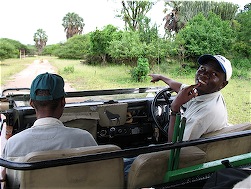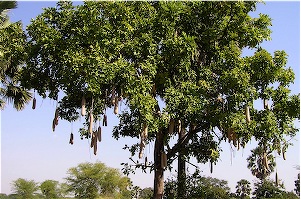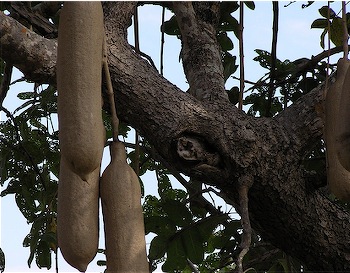I learned This from A Sausage Tree
It was a hot July afternoon in the lower Rift Valley and the African sun was beating down unmercifully. We had finally found a hiding place under the forest canopy at the Liwonde Game Park. Most of the teams who had come to work during their summer vacations had returned to their respective home nations and this gave us an overnight reprieve for a short get away.
hiding place under the forest canopy at the Liwonde Game Park. Most of the teams who had come to work during their summer vacations had returned to their respective home nations and this gave us an overnight reprieve for a short get away.
The guide sat in the front of the Land Rover in such a way that he could scan the forest in front of us, and at the same time be able to turn and talk with us. The driver, wearing the same kind of brown khaki outfit said little. He carefully scanned the forest for danger, and for whatever they next wanted to point out to us.
A Tree With Sausage Links
I listened as the guide described the animals we were seeing. He did it as though they were friends of his, and I guess in a way they were. He saw them often. He knew them well. He even knew the names many of the guides had assigned them. It was the same with the trees and the plants. After passing a herd of grazing impala we rounded a curve in the sandy dirt path. The driver slowed, then stopped. Almost immediately overhead was a very large sausage tree. Technically it is called the Kigelia Africana or Kigelia pinnata, but frankly don’t you like the name sausage tree better? There is nothing to compare with it in the states. It has giant stems from which hang long grey fruits that look exactly like long links of sausage, thus the name sausage tree. Oscar Mayer would certainly be envious!
The guide opened his narration by telling us how these sausages grow to as much as a meter (3 feet) in length, and can weigh as much as 10 kg (over 20 lb). I was glad we were not sitting directly under the tree. That would give you a real splitting headache if one fell on you. A baboon scurried across the path in front of us and up a nearby tree where he could get a better view of us from a safe position. The guide seemed not to notice as he continued his explanation of the tree.
weigh as much as 10 kg (over 20 lb). I was glad we were not sitting directly under the tree. That would give you a real splitting headache if one fell on you. A baboon scurried across the path in front of us and up a nearby tree where he could get a better view of us from a safe position. The guide seemed not to notice as he continued his explanation of the tree.
He described the value of the tree to the forest animals, especially the elephants, baboons and monkeys. That was impressive.
A Pharmaceutical Library of Value
The most amazing information about the sausage tree came later when I had the opportunity to learn of it’s medicinal values. It reads like a whose who of a pharmaceutical library.
The sausage tree and its fruit is used to treat fungal infections, boils, psoriasis, and eczema, as well as leprosy, syphilis and skin cancer. It is also used in the treatment of dysentery, ringworm, tapeworm, post partum hemorrhaging, malaria, diabetes, pneumonia and even toothache. The Tonga tribes on the Zambezi also use its ingredients for a face cream that gives them a blemish free complexion.
There Are Vast Differences
One is struck by a number of things when a westerner is introduced to facts such as these. The first is certainly the fact that Africa, with its unique environment, and people, are very different from the rest of the world. At first glance it looks very much the same, but down deep where it lives and breathes there are vast differences that can only be learned by spending a lot of time listening and observing.
Africa, with its unique environment, and people, are very different from the rest of the world. At first glance it looks very much the same, but down deep where it lives and breathes there are vast differences that can only be learned by spending a lot of time listening and observing.
Two, Africa has so much to give. It is and has a wealth of value for those who will take the time to learn about it before speaking or acting.
And third, the survival of the environment is critical to our very survival. All around us our Creator has placed the ingredients for life giving and life saving. We dare not destroy it.
These are some of the things I learned from a Sausage Tree.
